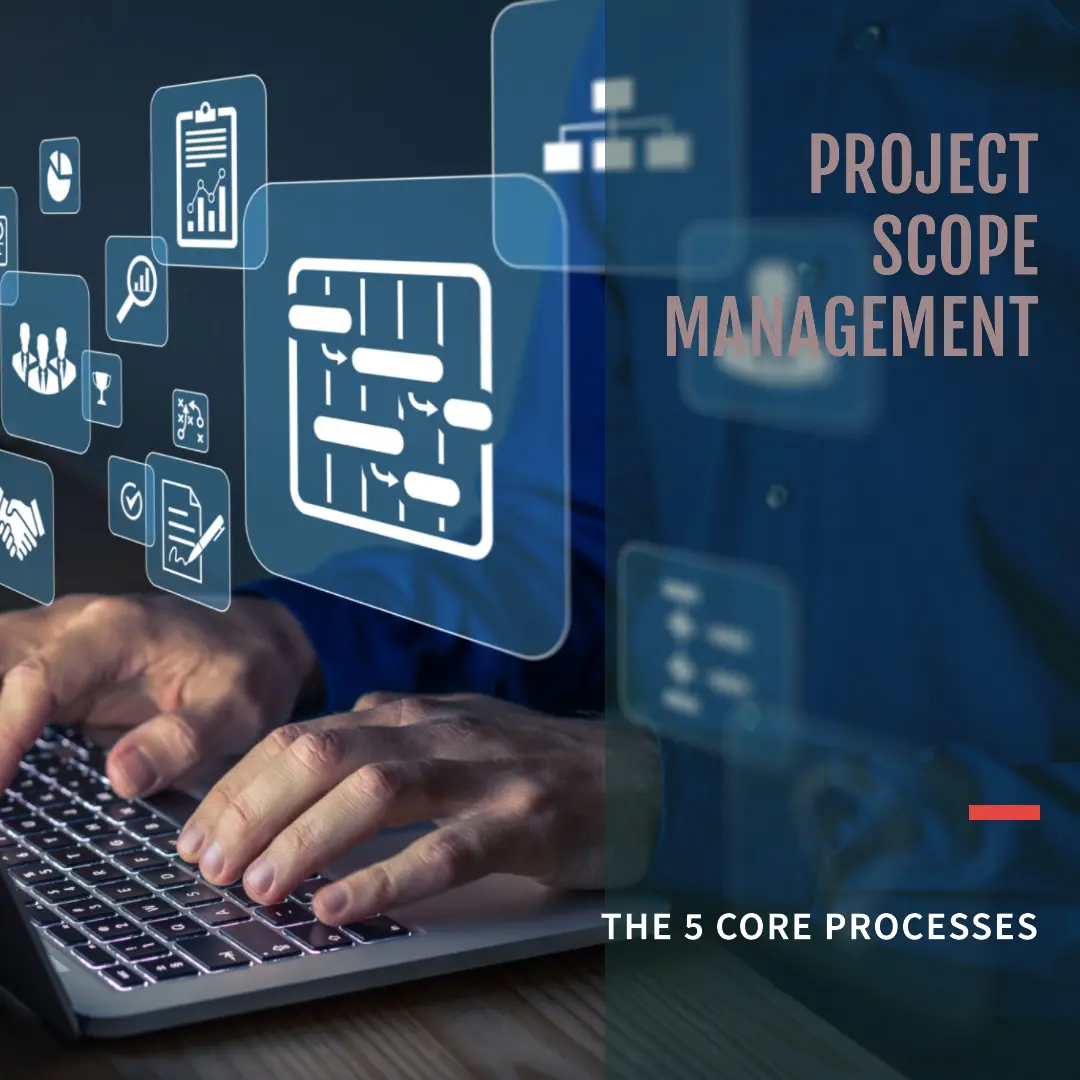I. Introduction
Hello, fellow project management enthusiasts! Have you ever found yourself amidst a project that seemed to spiral out of control, with countless changes and miscommunications leaving your team frustrated and lost? If so, you’re not alone. The key to avoiding such chaotic situations lies in mastering project scope management. In this blog post, we’ll delve into the five core processes of project scope management, discuss their importance, and share best practices for implementation. By the end of this post, you’ll be well-equipped with the knowledge and tools to effectively manage your project scopes and lead your team to success!
But first, let’s take a moment to understand what project scope management is all about. At its core, it involves defining and controlling what is and isn’t included in a project. Effective scope management ensures that all the necessary work—and only the necessary work—is planned, executed, and controlled, preventing scope creep, budget overruns, and missed deadlines. In essence, it’s the compass that keeps your project on track.
In this post, we’ll explore the five core processes that make up project scope management:
- Plan Scope Management
- Collect Requirements
- Define Scope
- Create Work Breakdown Structure (WBS)
- Control Scope
As we discuss each process, we’ll provide you with helpful tips, insights, and best practices, empowering you to take control of your projects and lead them to successful completion. So, grab your favorite beverage, find a comfy spot, and let’s get started on our journey to project scope management mastery!
II. Process 1: Plan Scope Management
Alright, let’s kick things off by diving into the first core process of project scope management: planning. Just like planning a vacation or a dinner party, planning the scope of a project is essential to its success. So, buckle up and let’s explore the ins and outs of planning scope management together!
A. Definition and objectives
Plan Scope Management is the process of creating a framework for how the project scope will be defined, documented, verified, controlled, and managed throughout the project lifecycle. It’s like laying the groundwork for a sturdy building; without a solid foundation, the whole structure can crumble.
B. Key components and best practices
To create an effective scope management plan, you need two primary components:
- Scope Management Plan: This document outlines the processes, tools, and techniques that will be used to define, monitor, and control the project scope. It serves as a roadmap for your team, ensuring everyone knows how the project scope will be managed from start to finish.
Best Practice: To create a strong scope management plan, involve key stakeholders and team members in its development. Their input can provide valuable insights and help to align everyone’s expectations.
- Requirements Management Plan: This document details how project requirements will be identified, analyzed, documented, and managed throughout the project. It helps to ensure that all requirements are captured accurately and that any changes are handled appropriately.
Best Practice: Be sure to define clear criteria for prioritizing requirements and establish a process for managing changes to requirements. This will help prevent scope creep and keep your project on track.
C. Tips for effective planning
As you embark on the planning phase of your project, keep these tips in mind to maximize your chances of success:
- Engage stakeholders early and often, as their input can help shape the project scope and requirements.
- Set clear expectations and communicate them to your team, helping to prevent misunderstandings and misalignments.
- Be realistic about the project scope, taking into account available resources, timelines, and constraints.
With a well-thought-out plan in place, you’re now ready to move on to the next phase of project scope management: collecting requirements. Let’s dive in and discover how to capture all those critical project needs!
III. Process 2: Collect Requirements
Now that we have our scope management plan in place, it’s time to roll up our sleeves and get to work on collecting the requirements for our project. This crucial step ensures that we fully understand the needs and expectations of our stakeholders and can create a project scope that meets their objectives. So, let’s jump into the exciting world of requirements gathering!
A. Definition and objectives
Collect Requirements is the process of determining, documenting, and managing the needs and expectations of stakeholders to establish a solid foundation for the project scope. Think of it as creating a detailed shopping list for your project, outlining everything you’ll need to deliver a successful result.
B. Techniques for collecting requirements
To ensure that you capture all relevant requirements, consider using a combination of these tried-and-true techniques:
- Interviews: Conduct one-on-one interviews with key stakeholders to gain in-depth insights into their needs and expectations. This is a fantastic opportunity to ask probing questions and encourage open, candid conversations.
- Focus groups: Bring together a group of stakeholders or subject matter experts to discuss and brainstorm project requirements. This collaborative approach can help uncover new ideas and perspectives that may not emerge during individual interviews.
- Surveys: Use questionnaires or surveys to gather input from a larger group of stakeholders. This can be particularly helpful when dealing with a geographically dispersed audience or when you need to gather a broad range of opinions.
- Observations: Observe stakeholders or users in their work environment to better understand their needs and identify potential requirements. This hands-on approach can provide valuable insights into how your project can best support their daily tasks and goals.
C. Best practices for gathering accurate and comprehensive requirements
As you embark on your requirements-gathering journey, keep these best practices in mind to ensure a smooth and successful process:
- Involve a diverse group of stakeholders, including end-users, to capture a wide range of perspectives and needs.
- Use multiple techniques to gather requirements, as each method can reveal different insights.
- Validate requirements with stakeholders to ensure accuracy and completeness.
- Keep an open mind and be prepared to adapt your approach as new information emerges.
By following these guidelines, you’ll be well on your way to creating a comprehensive and accurate list of project requirements. With this essential information in hand, you’re now ready to tackle the next phase of project scope management: defining the scope. Let’s dive in and start shaping our project’s future!
IV. Process 3: Define Scope
We’ve made great progress so far, gathering all those crucial requirements that will help guide our project to success. Now it’s time to take those requirements and use them to define the project scope. This step is like painting a vivid picture of our project, capturing all its key elements and setting clear boundaries. So, let’s grab our brushes and start creating a masterpiece together!
A. Definition and objectives
Define Scope is the process of developing a detailed description of the project, including its deliverables, boundaries, constraints, and assumptions. This serves as a reference point for all project stakeholders, ensuring everyone understands exactly what the project entails and what it aims to achieve.
B. Key components of a well-defined scope
To create a clear and concise project scope, focus on these three essential components:
- Project boundaries: Clearly outline the limits of your project, specifying what is and isn’t included. This helps prevent misunderstandings and keeps everyone focused on the tasks that truly matter.
- Deliverables: List the tangible outputs your project will produce, such as products, services, or results. Be as specific as possible, describing the features, functionality, and characteristics of each deliverable.
- Constraints and assumptions: Identify any factors that may impact your project, such as time, budget, or resource limitations, as well as any assumptions you’re making about the project environment.
C. Tips for creating a clear and concise project scope
As you work on defining your project scope, keep these helpful tips in mind to ensure a successful outcome:
- Use clear, concise language that is easy for all stakeholders to understand.
- Be as specific as possible, providing details that leave little room for interpretation.
- Involve stakeholders in the scope definition process, soliciting their input and feedback to ensure alignment and buy-in.
- Keep your scope flexible and adaptable, as changes may arise throughout the project lifecycle.
With your well-defined project scope in hand, you’re now ready to move on to the next exciting phase of project scope management: creating a Work Breakdown Structure (WBS). Let’s delve into this powerful tool that will help us bring our project to life!
V. Process 4: Create Work Breakdown Structure (WBS)
We’re making fantastic progress, my friends! With our project scope defined, it’s time to break it down into manageable chunks that will guide our team’s efforts throughout the project. That’s where the Work Breakdown Structure (WBS) comes in, helping us organize and visualize our project’s scope in a way that’s easy to understand and execute. So, let’s dive in and start breaking things down together!
A. Definition and objectives
The Work Breakdown Structure (WBS) is a hierarchical decomposition of the project’s scope into smaller, more manageable components. It provides a clear visual representation of the project, making it easier for team members to grasp their roles and responsibilities and stay focused on their assigned tasks.
B. Benefits of using a WBS in project scope management
Creating a WBS offers several advantages in managing project scope, including:
- Improved communication: A well-structured WBS helps ensure everyone on the team understands the project’s objectives and their role in achieving them.
- Enhanced planning and scheduling: Breaking the project down into smaller tasks allows for more accurate estimation of time and resources required, leading to more effective planning and scheduling.
- Better risk identification: By analyzing the individual components of the WBS, project managers can more easily identify potential risks and develop strategies to mitigate them.
C. Steps to create a WBS
To create an effective WBS, follow these simple steps:
- Identify major deliverables: Start by listing the primary deliverables defined in your project scope. These are the high-level outputs your project is expected to produce.
- Break down deliverables into smaller components: For each major deliverable, decompose it into smaller tasks or sub-deliverables. Continue breaking down these components until you reach a level that’s manageable and easy to estimate.
- Assign resources and responsibilities: Once you have a detailed breakdown of tasks, assign resources and responsibilities to each one. This will help ensure that everyone on the team knows what they’re accountable for and can focus on their assigned tasks.
D. Best practices for creating an effective WBS
As you work on your WBS, keep these best practices in mind to maximize its effectiveness:
- Use a consistent and logical structure, making it easy for team members to follow and understand.
- Focus on deliverables, not activities, to ensure the WBS accurately reflects the project’s scope.
- Keep the WBS up to date, revising it as needed to reflect changes in the project scope or deliverables.
With your WBS in place, you’re now ready to tackle the final phase of project scope management: controlling the scope. Let’s explore how to keep our project on track and prevent that dreaded scope creep from sneaking up on us!
VI. Process 5: Control Scope
We’ve come a long way together on our project scope management journey, and now it’s time to tackle the final piece of the puzzle: controlling the scope. This crucial step ensures our project stays on track, preventing scope creep and helping us deliver a successful result. So, let’s gear up and learn how to master the art of scope control!
A. Definition and objectives
Control Scope is the process of monitoring the project’s progress, comparing it to the planned scope, and managing any changes that arise throughout the project lifecycle. It’s like keeping a watchful eye on your project, ensuring it stays on course and making adjustments as needed to keep it aligned with the original scope.
B. Techniques for monitoring and controlling scope
To effectively control your project’s scope, consider using these powerful techniques:
- Variance analysis: Regularly compare your project’s actual progress with the planned scope to identify any discrepancies or deviations. By catching these variances early, you can take corrective action and get your project back on track.
- Change control process: Establish a formal process for handling change requests that impact the project’s scope. This should include evaluating the impact of the change, obtaining stakeholder approval, and updating the project scope and WBS accordingly.
C. Strategies for preventing scope creep
Scope creep—the gradual expansion of a project’s scope beyond its original objectives—can lead to budget overruns, missed deadlines, and even project failure. To keep scope creep at bay, consider these strategies:
- Clearly define your project’s scope from the outset, ensuring all stakeholders understand and agree on the project’s objectives and boundaries.
- Establish a change control process and stick to it, requiring stakeholders to submit any scope changes through this formal channel.
- Communicate regularly with your team and stakeholders, keeping everyone informed of the project’s progress and any changes to the scope.
VII. Conclusion
And there you have it, dear readers! We’ve explored the five core processes of project scope management, delved into their importance, and shared best practices for implementation. By following the tips and insights we’ve discussed, you’ll be well on your way to mastering project scope management and leading your projects to success.
Remember, effective project scope management is an ongoing learning process, so don’t be afraid to continually refine and improve your approach. With dedication, practice, and the knowledge gained from this post, you’ll soon become a scope management pro, adept at navigating even the most complex projects with ease and confidence.
As we wrap up our journey together, I’d like to leave you with a few final thoughts. Embrace the challenges that come with managing project scope, as they provide valuable opportunities for growth and learning. Stay curious, ask questions, and never stop seeking new ways to improve your skills. And most importantly, remember that you’re not alone—lean on your team, collaborate with stakeholders, and share your knowledge and experiences with others in the project management community.
Thank you for joining me on this adventure through project scope management. I hope you’ve found it enlightening, informative, and engaging. Here’s to your continued success in managing your projects and delivering exceptional results! Happy scoping, my friends!
To find out how Artificial Intelligence is changing the Project Management landscape, you have enjoy reading this article https://www.shaunstoltz.com/did-artificial-intelligence-just-change-everything-about-project-management/
Find out more about Shaun Stoltz https://www.shaunstoltz.com/about/
This post was written by an AI and reviewed/edited by a human.



